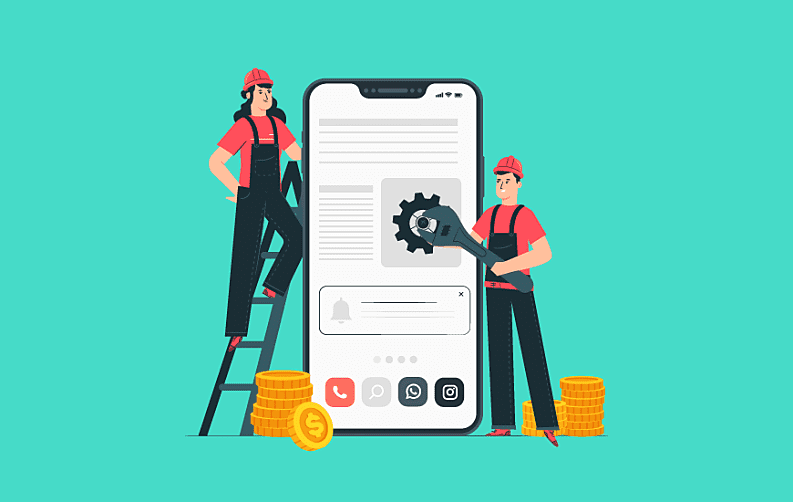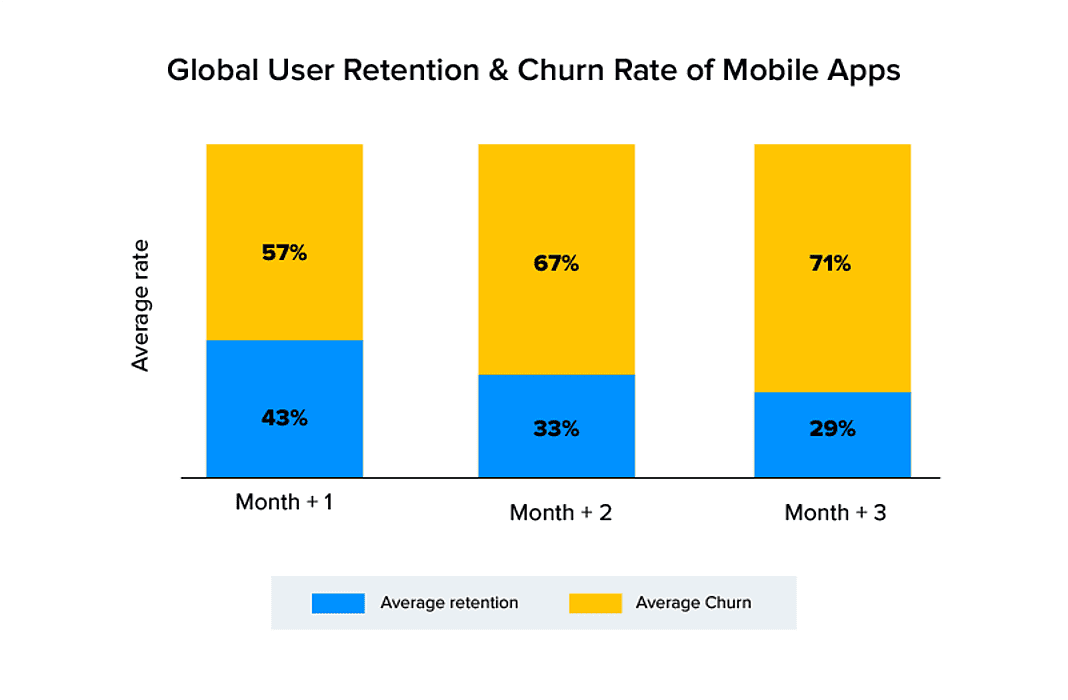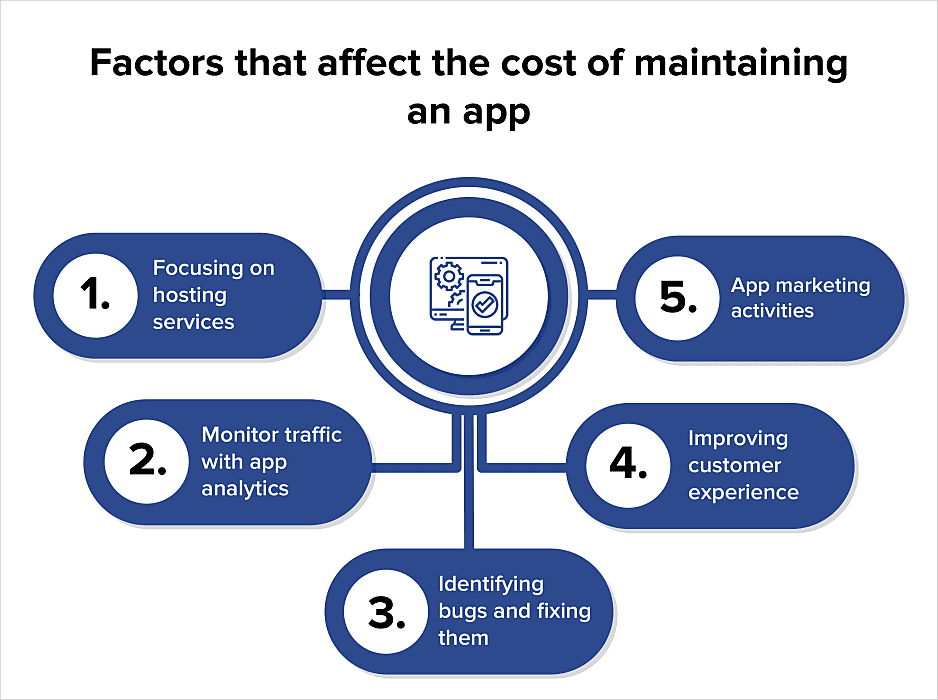
App maintenance is a recurring and crucial task for every app. Even if you had built an amazing app and added every possible security and safety feature, apps can still have glitches revealing themselves after some time. Therefore, the need for mobile app maintenance occurs.
App maintenance is not only important due to glitches, apps can be upgraded, modified, and much more. Whenever you plan to develop an app, apart from the development cost of the app, it is a smart move to measure the approximate cost of maintaining an app. It will help you in avoiding sudden burdens in case of any unpredictable event.
Experts usually suggest that app maintenance can cost 15-20% of the total development cost.
Now, before diving into further details related to app development costs, let’s see how regular app maintenance can align your app strategy to secure more growth.
Why is mobile application maintenance important?
Well, the answer to this question is obvious. Maintenance can be used to keep the application fresh, free it from glitches, upgrade the UI and UX, etc. By obtaining top-notch app maintenance services, you also impact the user retention rate positively as it helps you in offering the best possible experience.
Let’s discuss in detail why mobile application maintenance is important:
1. Keep your application safe against glitches and flickering issues
Well, with time, manufacturers keep updating smartphones and their technologies. So, it might make your app incompatible with new upgrades. It might cause security issues in your app, glitches, or UI/UX issues. Regular maintenance of your application will help you in avoiding these possible issues even before they occur.
2. Keep up with features and minimize uninstallations
If an app stops offering updated information and functionalities to users after a while, they will see no reason to use it and may even uninstall it. According to a An app can dissatisfy the user if it does not meet their needs, it’s too hard to use, or often glitches. A Statista report suggests that more than 70% of app users prefer uninstalling their apps within 90 days of installing them on their smartphones.
Additionally, another report shows that the average app uninstallation rate in the US was around 43% in 2020. An application with with glitches in its database motivates users to give up on it.

Therefore, it’s crucial to invest in app maintenance to keep your app fresh and error-free. Your app maintenance cost should ensure the usability of the app has become easier compared to before. This will significantly raise the app’s retention rate.
3. The goal is to thrive through the competition
There are millions of apps out there competing to gain users’ attention. So, it is crucial to understand that your app’s goal is to win against all odds so you can build its permanent reputation in the market. That goal is possible to achieve by using strategic upgrades.
With time, you should keep maintaining your app, update it technologically, improve the UI, and make sure it evolves with the evolving technology. Keeping an eye on what competitors are doing and how well it is working for them can also be beneficial.
4. To build long-lasting goodwill for your application
An error-free and technologically advanced app can have a good reputation. For the exchange of recurring app development and maintenance costs for your app, you can expect brand loyalty and users’ satisfaction in return. Moreover, suppose if you plan to launch another app in the future, a good experience will make users trust more on your app.
5. Getting rid of downtimes
Downtimes are nightmares that turn into reality for developers, if not taken care of in advance. Many ways can be taken to avoid possible downtimes like regular updates, compatibility with the latest technology, protection against hacking attempts, etc. Downtimes can cause huge revenue losses to developers, you should plan a part of app maintenance cost to avoid such incidents.
How much does it cost to maintain an application and keep it running?
Well, figuring out the exact costs of maintaining an app is tricky as it involves multiple predictable and unpredictable aspects. But during the first year after launch, your app maintenance costs can be 50% of the initial app development cost.
This may happen due to the numerous upgrades you might want to introduce in response to the feedback received by your users. Later on, the costs of maintaining an app can be around 15 to 20% of the initial app development cost on a yearly basis.
However, there are some additional possibilities for answering this question, I am going to mention them further for your reference.
- The cost of hiring a developer or a small app development company can influence the average cost of maintaining an app.
- As mentioned earlier, the predictable cost to maintain an app might reach up to 20% of the total cost to develop an app.
- According to the breakdown we mentioned above, the average cost of maintaining an app can fall between $400 to $900 per year. It can have a huge variation depending on your market location, type of technology, and type of upgrade;
- The amount spent on the app marketing strategy will also be counted as your total application maintenance cost.
Additional Factors Affecting the Cost to Maintain an App

There are several factors that impact the overall cost to maintain an app. Some of these factors include introducing new features and functionalities, fixing bugs, focusing on marketing activities, and more.
In this section, we will dive into those factors that determine how much does it cost to maintain an application in detail. So, let’s get started!
1. Focusing On Hosting Services
As a developer, you know that hosting is a recurring cost. It is something your app can not function without. Therefore, you can invest application maintenance and support money according to your budget and that will provide you with limited-time access to the server.
However, apart from the duration of the hosting, the type of your app data will also matter. You would also want to consider CPU memory, supporting media types on the server, other features the hosting provider offers, etc. There are some leading organizations like Amazon web services, Hostgator, etc which offer special discounts on hosting services.
2. Monitor Traffic With App Analytics
Well, analytics is important to measure the real growth of your application. Therefore, these are application maintenance and support costs you can not avoid. Analytics will demand the cost of app maintenance for services like traffic measures, traffic sources, user behavior, average app usage time, etc.
Moreover, tools like Google Analytics can also help you in figuring out which part of your application is seeing more growth so you can either take inspiration from it or focus on it to maintain its growth.
3. Identifying Bugs And Fixing Them
Bugs can appear unexpectedly anytime for any reason like server updates, hosting upgrades, device changes, etc. However, the cost of detecting bugs and fixing them can vary as it depends upon the type of bug and the time it will take to get rid of it. Moreover, the Android and iOS app maintenance also depends on multiple other triggers like the complexity of codes, security protocols, the experience of the team, etc. The average maintenance cost to edit one line of code is $50.
4. Improving Customer Experience
Solving app-related problems raised by customers is also a crucial role for any developer. You have to take their feedback seriously and resolve them. However, it is not always possible for an individual developer or a team of developers to interact with users directly. To solve that problem, Customer Service Representatives (CSR) will come into the role. Even though it’s a cost as well, being responsive to users’ queries creates nice goodwill.
5. App marketing activities
Well, developing and publishing apps is not the end of the responsibility. Users need to know about every change they are going to make to the app to build their trust. Especially if these modifications affect the privacy, data, or payment info of users. For every new upgrade or modification in the app, you will have to do promotional activities. It will attract costs that can not be avoided and eventually increase your Android or iOS app maintenance costs.
6. Outsider service providers
While developing your app, you have the option to choose licensed technology for a fee. Uber and Zomato are some of the apps that utilize features of Gmail accounts to leverage their features within the app itself. So, when using outside service providers, calculate such third-party costs to determine the final app development cost.
7. Upgrading features and functionalities
You must have observed that many popular apps add something new to stand out. For example, gaming apps like subway surfer, or temple run, invested in upgrading their graphics. Moreover, food delivery apps like Zomato and Swiggy adapted live tracking systems for their orders. It improved users’ satisfaction without any doubt. However, this will add to the overall maintenance costs.
Apart from that, here are a few other elements that might affect the mobile app maintenance cost:
- Servers: $(20- 60)/ month
- Push notifications: $10/ month
- Payment gateways: $149+/ month
- Additional unpredictable events: Depends upon the event
Tips To Reduce Mobile Application Maintenance Cost
Well, certain ways can be used to reduce the investment in mobile app maintenance:
1. Picking the Right Development Program
Choosing the right platform can affect the cost, effort, and time you will invest in iOS or Android app maintenance. There are two types of app development platforms existing at the moment:
- Native App Development
- Hybrid App Development
In the comparison of native apps vs hybrid apps, native apps are platform-specific. In other words, you have to develop multiple native apps for multiple operating systems like iOs, Android, Windows, etc. However, native apps are usually faster and consume less space once installed. These apps are also able to offer better features as developers specifically focus on making these apps for one particular type of operating system. Native apps, however, require separate iOS and Android app maintenance expenditures.
If we talk about Hybrid apps, they’re cross-platform, as the name suggests. Though building one app for multiple operating systems is naturally a time-saving and cost-saving process. If you want to offer services on multiple platforms with limited features, you should consider developing a hybrid application as it will save you from maintaining multiple apps separately. From an even long-term point of view, you are saving investment. To save the cost of app maintenance tasks, hybrid apps are the best choice.
2. Focus on constructing an MVP App
The minimum viable product (MVP) means an app with only basic features and a minimized user interface. Hence offering many useless features can increase the app size, loading time, and chances of app crashes. So, it is recommended that you develop an app with important features for your users.
You can add features later according to the feedback you receive from your users. Or, you can keep an eye on competitors or trends and plan app upgrades accordingly, if it doesn’t reduce the performance of your app.
3. Following the latest development trends
The most ideal way to reduce the requirement for frequent maintenance is to keep up with the latest technology trends. Depending on the type of app, you can find suitable sources like MobileAppDaily to keep up with the latest UI trends. Or, you can keep up with other information such as top IoT trends to keep your apps fresh for markets.
Final Words
If you observe the market, you will find that many of the top mobile app development companies are applying these tactics while they are trying to build applications for their clients. The reason is that apps of many types are increasing in the industry. Therefore, the competition is much higher and every step taken towards the development can either improve your apps’ reputation or depreciate it. However, following these standard procedures can help you in planning your cost and keeping it as minimum as possible.
We hope that we provided you with satisfactory information. Moreover, keep visiting MobileAppDaily for more informative blogs for all your app development needs.
Frequently Asked Questions
-
How much does it cost to keep an app running?
After the completion of the mobile app development process, the next step is to keep the app running that too without any glitches. And for that, you need to shell out a maintenance cost which is around 15 to 20% of the original development costs. For instance, if the cost of developing an app is $10,000, then the cost of maintaining an app stands to be around $2000 annually.
-
How do you maintain an app?

















